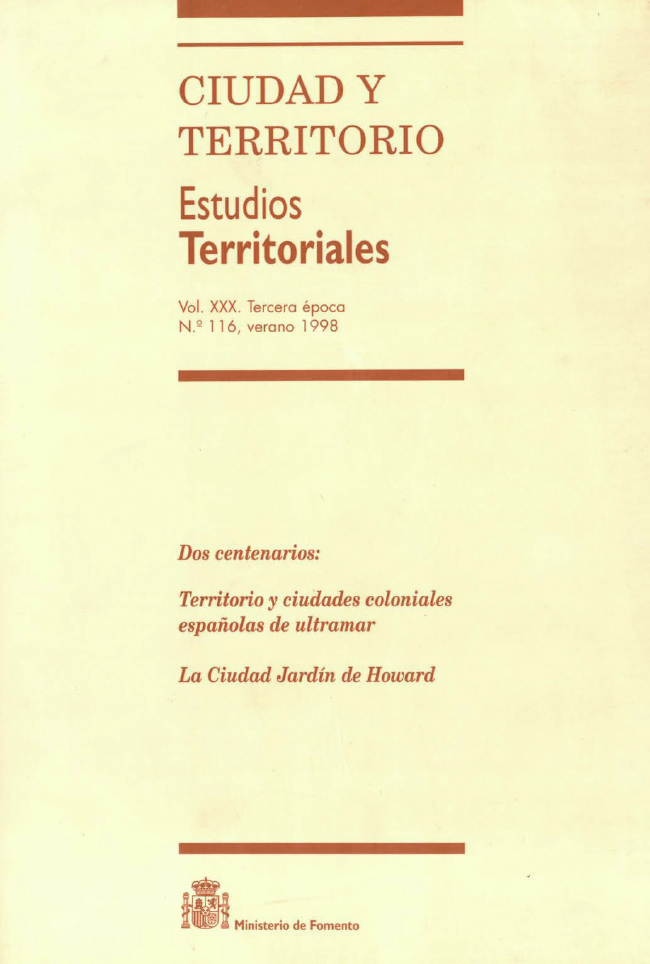Spain in Micronesia: San Ignacio de Agaña as the First City in Oceania
Keywords:
Territorio, Historia del Urbanismo, Palaos, Marianas, CarolinasAbstract
The paper remarks that the Palau, Marianas and Carolines archipelagos in the Pacific were, until sold to Germany in 1899, Spain's last overseas possessions. Having plotted the history of the Marianas from their discovery by Magellan and Elcano in 1521 through to the arrival of the Jesuit Diego Luis de San Vítores in 1668 with whom Spanish sovereignty there could be said to have really established itself, the author mentions that it was the island of Guam that most thoroughly experienced Spain's presence given that it was the only safe watering point available for the Acapulco galleon. Urbanistic activity was at best scant, as much for reasons of terrain as population, the village of the Marianas holding to their original native character with but few and infrequent buildings laid out upon an incipient ground plan, these keeping to the model to be found in the White Villages of Southern Spain. San Ignacio de Agana is an exception, being for long enough not only the first but the only city in Oceania. Until its destruction in 1944, it embodied a civilisation born of both fusion and cross-breeding, its lay out being structured around that open space which was the Plaza de España, keeping in this to the canons laid down in the Ley de Indias. The paper finishes by remarking the Spain's political presence in the Carolines was for but some few years at the end of the 19'h C. when two naval bases were set up after 1886, one, Santa Cristina, on Yap, the other, Santiago de la Ascension, on Ponape.
Downloads
Downloads
Published
How to Cite
Issue
Section
License
Copyright (c) 1998 Javier Galván Guijo

This work is licensed under a Creative Commons Attribution-NonCommercial-NoDerivatives 4.0 International License.
Considering the provisions of the current legislation on Intellectual Property, and in accordance with them, all authors publishing in CyTET give -in a non-exclusive way and without time limit- to the Ministry of Transport, Mobility and Urban Agenda the rights to disseminate, reproduce, communicate and distribute in any current or future format, on paper or electronic, the original or derived version of their work under a Creative Commons Attribution-NonCommercial-NoDerivative 4.0 license International (CC BY-NC-ND 4.0), as well as to include or assign to third parties the inclusion of its content in national and international indexes, repositories and databases, with reference and recognition in any case of its authorship.
In addition, when sending the work, the author(s) declares that it is an original work in which the sources that have been used are recognized, committing to respect the scientific evidence, to no longer modify the original data and to verify or refute its hypothesis. Author(s) also declare that the essential content of the work has not been previously published nor will it be published in any other publication while it is under evaluation by CyTET; and that it has not been simultaneously sent to another journal.
Authors must sign a Transfer of Rights Form, which will be sent to them from the CyTET Secretariat once the article is accepted for publication.
With the aim of promoting the dissemination of knowledge, CyTET joins the Open Journal Access (OA) movement and delivers all of its content to various national and international indexes, repositories and databases under this protocol; therefore, the submission of a work to be published in the journal presupposes the explicit acceptance by the author of this distribution method.
Authors are encouraged to reproduce and host their work published in CyTET in institutional repositories, web pages, etc. with the intention of contributing to the improvement of the transfer of knowledge and the citation of said works.








 Enlace a CyTET en Linkedin
Enlace a CyTET en Linkedin